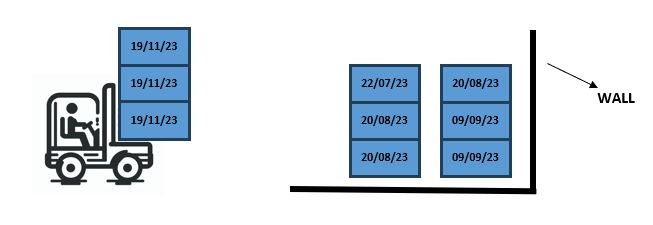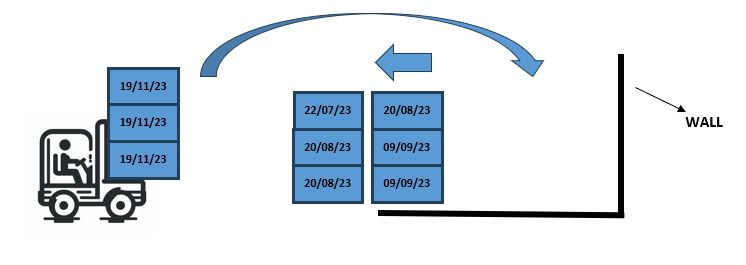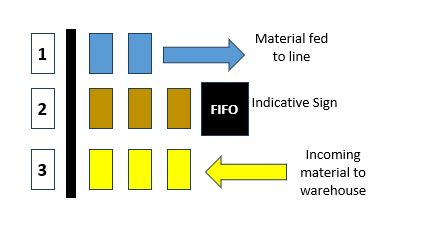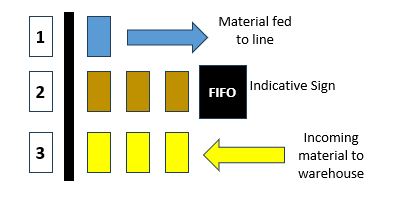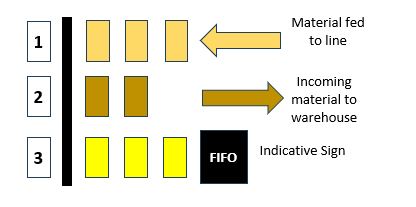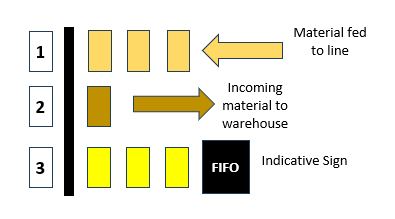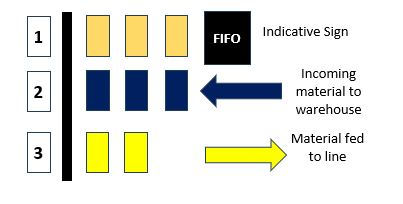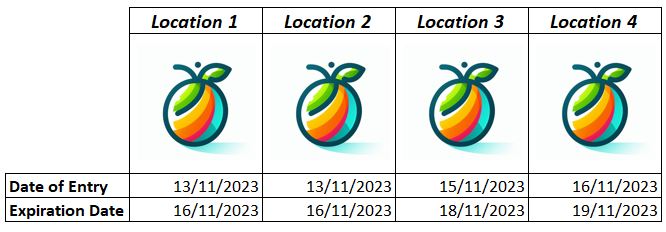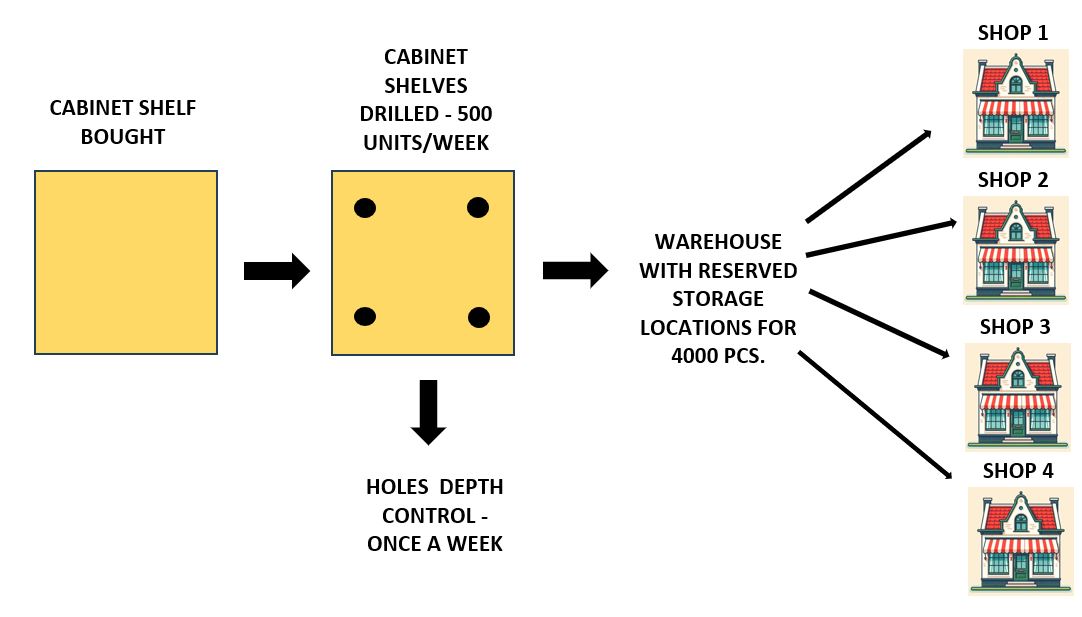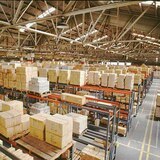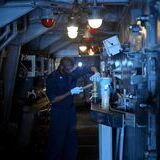Mastering Inventory Management with the FIFO Method: Benefits and Strategies
Introduction to the FIFO method
The FIFO (First-In First-Out) method, translated into English as First-In First-Out (FIFO), means that the first goods to enter a warehouse should be the first to leave it.
This system is suitable for perishable products in sectors such as food, cosmetics or medicines. It is also used in sectors that manufacture electronic products or in the automotive sector.
Operation of the FIFO method
As mentioned in the FIFO method, the first thing in will be the first thing out. Let's see how to correctly perform this operation in practice.
We will put two assumptions, one in which we only have a "lane" to leave the merchandise and another in which we will have more than one "lane" to deposit the merchandise.
Single "Lane"
Let's suppose we have boxes of 3 different dates of the same part number from the supplier:
- 1 box dated 22/07/2023
- 3 boxes from 20/08/2023
- 2 boxes from 09/09/2023
Now arrives at this time an entry of material dated today, let's assume 19/11/2023 with 3 boxes.
Step 1. Initial state of the material and input of new material
Before placing the new material, we have the state shown in the image in which, as can be seen, we have the oldest material in the first position to ensure that when feeding the line we will follow the FIFO.
Step 2. Movement of material to maintain FIFO
In this step, the two pallets with 3 boxes each will be moved to the back to make room for the new material of this reference, which should be consumed last.
Step 3. Final status at the location maintaining FIFO
The final state after the movement in step two would look as follows:
In this way, the forklift operator in charge of feeding the production line will already have the material in order to follow the FIFO.
Multiple "Lanes"
In this case we will imagine that we have three lanes per reference. To manage the FIFO we will do it in the following way:
- We will have a sign that has the word "FIFO" or a colour that has been defined in the manufacturing plant that means FIFO.
- This sign will be placed in one of the lanes, and indicates the next "lane" to be followed for the feeding of material to the line.
- The feeding to the line will be done from the lane above (in plan view). When the material is finished in this lane, it will go to the lane with the "FIFO" sign and this sign will be moved to the lane below (in plan view).
Let's see this explained graphically:
Step 1. Initial state of the material and entry of new material into lane 3
Here we see that we have the three streets for a given reference. It has been coloured in different colours to simulate different dates of entry into the warehouse.
Therefore we see that the material entry is done in lane 3, and that material is being fed to the line from lane 1. In lane 2 we have the FIFO sign indicating that when we finish the material from lane 1, we will have to go to lane 2.
Step 2. End line feed from lane 1
In this step, the feeding to the line is completed from lane 1.
Step 3. Start of line feed from lane 2 and material inlet to lane 1.
As we can see, after finishing the line feed from lane1, we have changed the sign to lane 3, and we begin to feed the line from lane 2.
The entry of material to the warehouse of this reference takes place in lane 1.
Step 4. End line feed from lane 2
In this step, the feeding to the line from lane 2 is completed.
Step 5. Start of line feed from 3rd Street and material inlet to 2nd Street.
When we finished feeding the line from lane 2, we changed the sign to lane 1, and we started to feed the line from lane 3.
The entry of material to the warehouse of this reference takes place in lane 2.
In what areas should FIFO be applied?
FIFO should be applied in all operations, especially in the automotive world, covering all areas where there is material:
- Component Receiving Warehouse
- Component Line Feeding Area
- WIPs and Buffers Area
- Rework Area
- Product Expedition Warehouse
Why use the FIFO method?
To explain the importance of implementing the FIFO method, let's make two simple examples.
In the first example we have the fruit that we currently have in the supermarkets that goes through the following processes:
- Fruit picking
- Transport to central warehouse
- Transport from central warehouse to supermarket for sale to the final consumer.
In the image above we see for example a scheme of 4 locations of a given fruit with its date of entry into the warehouse and have a shelf life of 3 days from entry. If the FIFO is not strictly followed and for example we are on 16/11/2023 and the material from bin 4 is sent, the fruit from bins 1 and 2 will be lost, because they will be rotten.
However, if a proper management is carried out taking into account that the first thing that comes in will be the first thing that is sent to the supermarket for sale when it is demanded, it should be sent what is in location 1 or 2, thus minimizing the product that becomes obsolete, in this case rotten.
In the second example, let's imagine a furniture factory and for simplicity's sake let's imagine that this factory buys shelves from a supplier and that it only has to make holes in them automatically, processing around 500 units per week. This factory keeps a stock of shelves already processed in its warehouse of approximately 4000 units, which will later be supplied to 4 stores. At the end of each week, the holes are measured to check if they meet the customer's specifications.
The warehouse has 8 reserved storage bins with a capacity of 500 shelves each.
Let's suppose that in principle there is no FIFO management at all in the factory warehouse, therefore, as the shelves with the necessary holes leave the line, they are introduced into storage bins, and when it is time to send them to the shop, only the reference is searched for and sent. Then, in the production finished on 17/11/2023, it turns out that when we measure the holes we realise that it does not meet specifications and therefore the entire production of the week is suspect. Since the FIFO has not been followed in shipments, it may be the case that a certain number of shelves produced on 17/11/2023 have already been shipped, as in this example in which they were already sent to the shops, and they sold them to the end customer, with the consequent dissatisfaction and cost for our company.
Si, por el contrario, se sigue el FIFO en el almacén de expediciones, las baldas fabricadas defectuosas, se quedaron en el almacén y es muy sencillo por la trazabilidad de producción de cada lote, realizar la contención del material sospechoso para revisarlo al 100%. De esta forma ni las tiendas, ni cliente final se verían afectados por el defecto, es decir, el método FIFO facilita en gran medida la contención del problema de calidad.
Como se ve, se habría seguido el método de operativa de varias calles mencionado arriba, y se habría enviado a las tiendas el lote fabricado el 06/10/2023, con una correcta calidad y satisfacción del cliente:
En cuanto a la contención del material defectuoso, habría sido mucho más facil que en el caso anterior, ya que tendríamos todo el material en el almacén para contenerlo y evitar su envío a cliente final.
Ventajas del método FIFO
A continuación se muestran las ventajas principales del método FIFO:
- Mejora la rotación de inventario: como hemos visto en el ejemplo de las frutas, esto puede ser crucial para algunas empresas.
- Reducción de desperdicios: el hecho de seguir el FIFO como hemos visto, evitará en la medida de lo posible que nos quedemos con producto obsoleto que no se puede vender o consumir (= pérdidas). Esto tiene como consecuencia aumento de los beneficios de la empresa.
- Optimización del espacio: Aunque el FIFO en sí no ahorra espacio físico, sí que tienen un impacto en la rotación y obsolescencia de los productos, por lo que puede contribuir indirectamente a un uso más eficiente de las zonas con producto almacenado. Una utilización eficaz del espacio suele ser el resultado de buenas prácticas de gestión del inventario, y el FIFO es una de esas prácticas que puede ayudar a optimizar el flujo global de mercancías en una empresa.
- Facilita la contención de los defectos de calidad: como se ha mostrado en el ejemplo de las baldas, el hecho de seguir el FIFO va a facilitar enormemente las contenciones de los problemas de calidad.
- Facilidad de implementación, la idea que transmite el FIFO como se ha descrito es muy simple, lo primero que entra es lo primero que sale.
Desafíos y limitaciones al aplicar FIFO
El FIFO en general no tiene desventajas significativas. La más destacable estaría relacionada con la contabilidad usando el FIFO como método de valoración de inventario, en la que la empresa asigna los costos más bajos a los bienes vendidos, lo que resulta en una utilidad bruta más alta y, por lo tanto, en un mayor monto sujeto a impuestos. Ilustremos esto con un ejemplo:
Una empresa realiza la compra de un componente. Dicho componente se compra en enero y en junio de ese mismo año:
- Precio Enero: 5 euros
- Precio Mayo: 10 euros
El componente imaginemos que se vende a 20 euros. Si seguimos el FIFO para calcular, se tomará el precio de enero.
- Utilidad Bruta por unidad: 20 - 5 = 15 euros
Esa utilidad bruta, al ser más alta que si se hubiera calculado con el precio de Mayo, resultará en un mayor monto sujeto a impuestos.
Aplicaciones prácticas de FIFO
En las siguientes industrias el FIFO se debe llevar a cabo de una manera estricta.
- Industria de alimentación: relacionado con lo comentado sobre los alimentos perecederos.
- Industria farmacéutica: debido a la caducidad de los medicamentos.
- Industria manufacturera: como en el ejemplo mostrado de la fábrica de muebles.
- Industria electrónica: dado que al haber avances tan rápidamente, los productos se quedan obsoletos pronto y hay que darles salida con prioridad.
- Industria automotriz: puesto que al llevar tantos componentes de industria manufacturera y electrónica que están sujetos a cambios es importante seguir un FIFO estricto.
- Construcción: es importante usar primero los materiales más antiguos.
- Industria química: para evitar que los productos químicos se queden obsoletos y no actúen como deberían.




